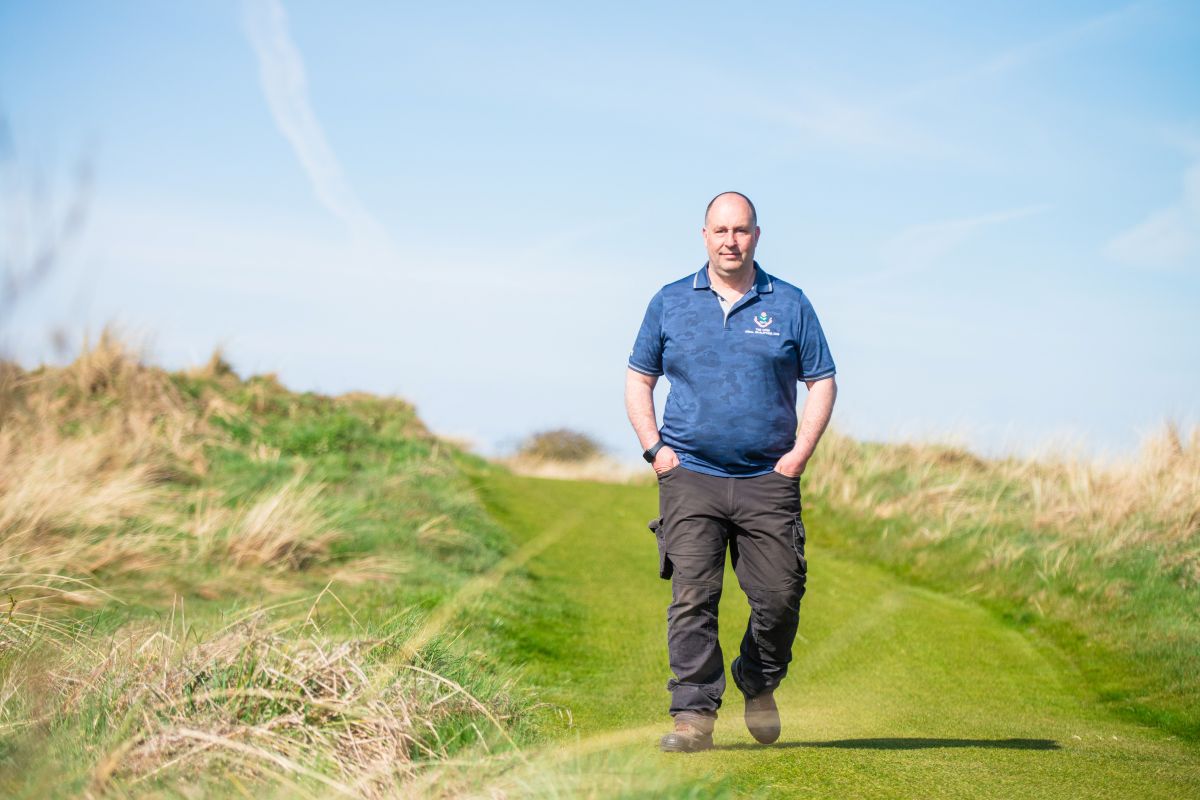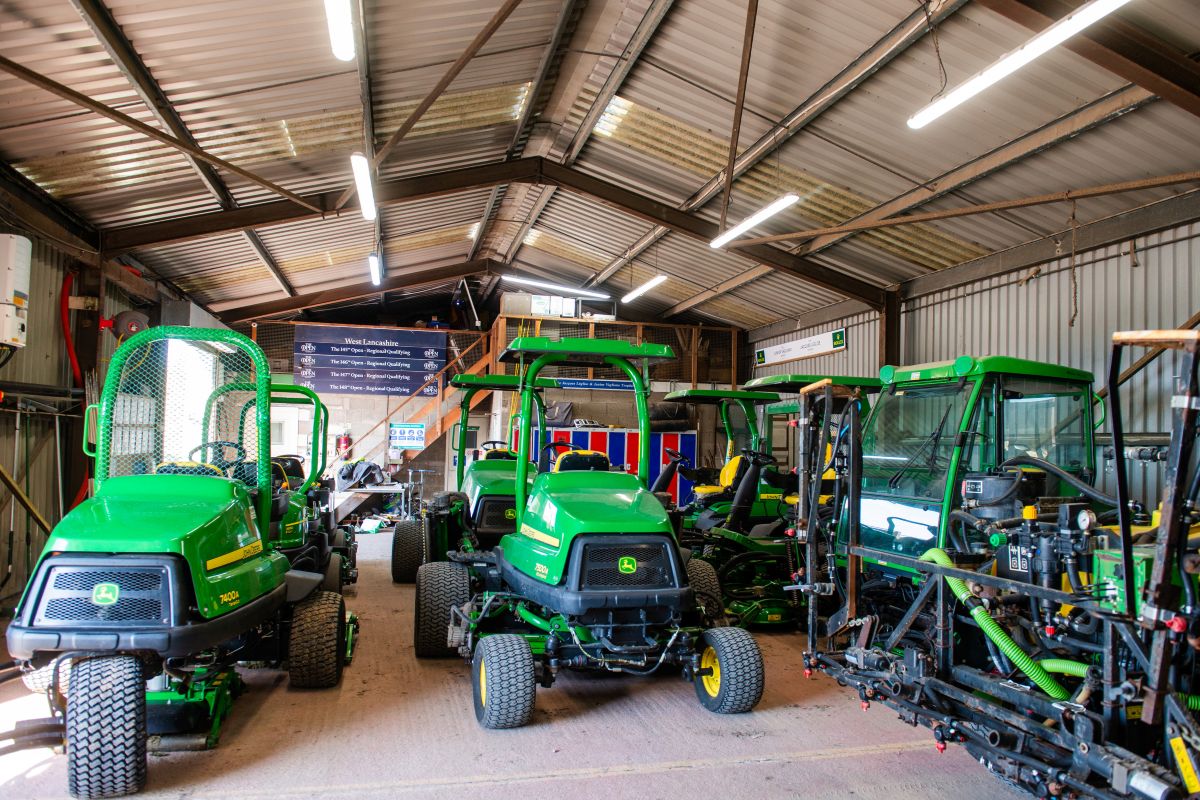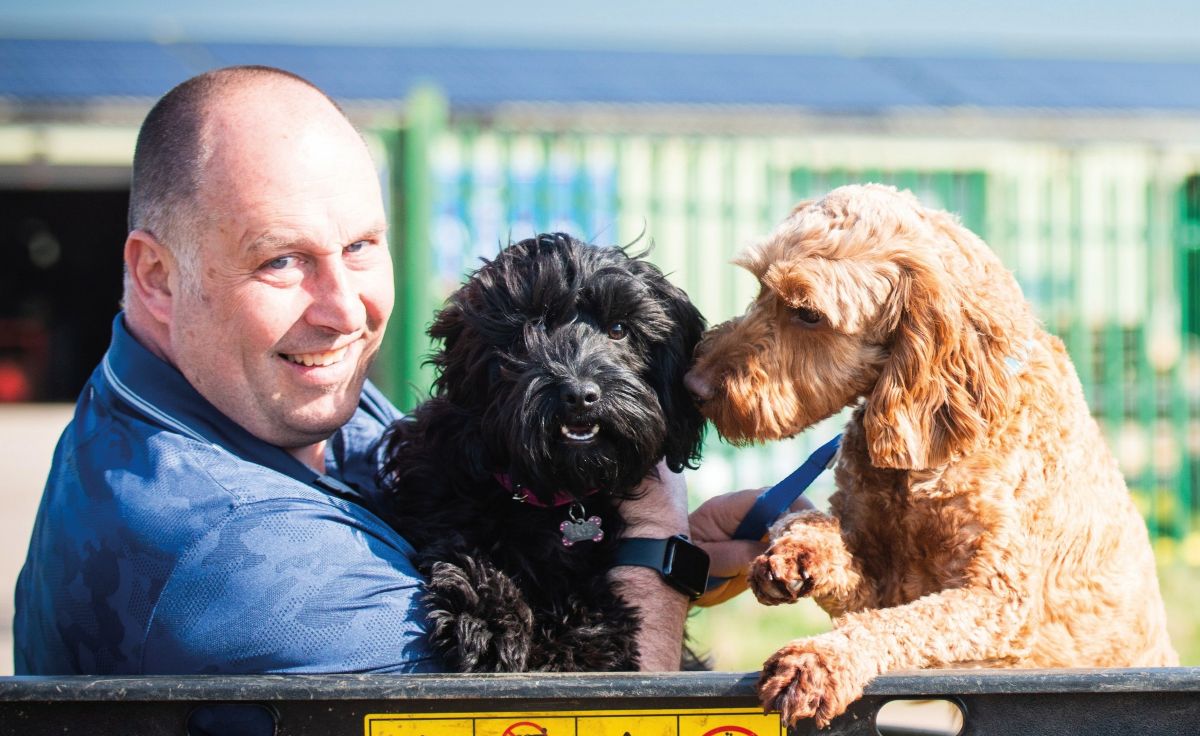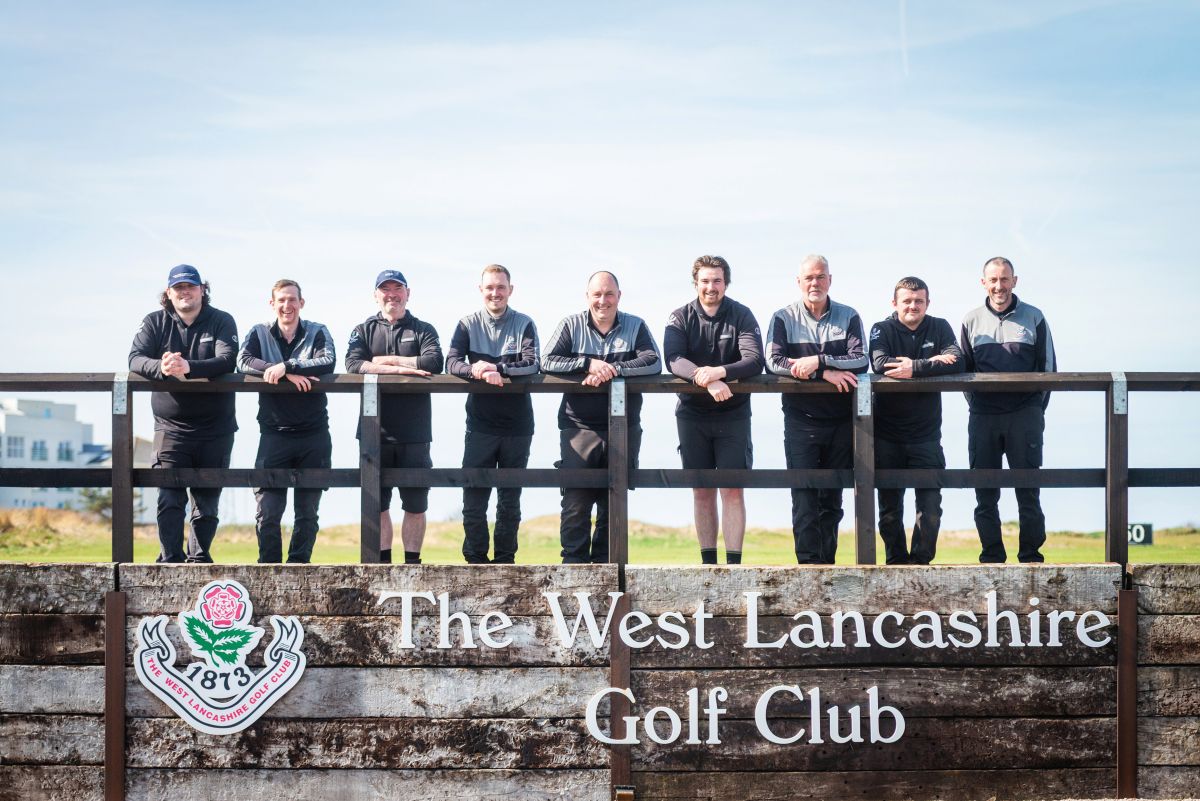- Homepage
- News and Features
- Stuart Hogg delivers at West Lancs
Stuart Hogg delivers at West Lancs
West Lancs has enjoyed a dazzling resurgence during the course manager’s decade at the helm.

Stuart Hogg knew from the start that restoring West Lancashire Golf Club to its rightful status as a top-tier links venue would require time, patience and no shortage of skill, but he was confident in his ability to deliver. With the backing of the club and buy-in from his team, Stuart has overseen a transformation at the Blundellsands course, showcasing what can be achieved when a course manager is given the agency to do what he knows is best.
We caught up with the 37th Master Greenkeeper who has been working wonders at West Lancs.
Open goal
Stuart was a promising goalkeeper in his younger years, playing for Kilmarnock and Dundee up until the age of 16. When he moved back to Largs in the west of Scotland, his job hunt came with only one condition – he needed to have his Saturdays free to play football. His father, who ran his own dentist’s, introduced him to an opening at West Kilbride. It was there that Stuart got his grounding, working Monday to Friday with the odd bit of weekend work, though never at the expense of a match. After four years, and with football steadily taking a back seat, Stuart moved on to Fortrose and Rosemarkie, where he ascended to the position of head greenkeeper in 1995 at the age of just 23. The Black Isle venue was also where he earned his Master Greenkeeper status.
Stuart then spent more than a decade at St Annes Old Links, getting a taste of R&A and European Tour events, all the while enhancing his own profile in the industry. “When I came down to England, my ambition was always to try and manage an Open Championship golf course, with Birkdale probably being the favourite, so I thought working at St Annes would give me a chance to learn about the area, weather patterns and so on,” he said. “This West Lancs job came up in 2015 and I saw it as an opportunity to move closer to Birkdale, but also as an opportunity in its own right. It definitely had its challenges, but I always thought that if I never got an Open Championship golf course, then West Lancashire would be a fantastic place to finish your career because it’s a phenomenal golf course and so underrated.”
The test was to deliver a course that lived up to that potential, a process Stuart knew would take time, and he was clear from the start about the timeframe, ensuring nobody was under any illusions about the journey ahead.
“I said from the start, after walking the golf course, that it’s a five-year turnaround, and that wasn’t wrong,” he said. “I wasn’t going to tell them I could turn it around in 12 months. I gave them a short, medium and long-term view of what we needed to do.
“First and foremost, we needed to make it more aesthetically appealing. The rough was an issue when I started and the club had already put a contractor in to cut and collect the areas prior to me arriving, so it really gave me a blank canvas to create the managed rough areas as I saw fit.
“We have since tweaked those cuts and in places we have continued the cut and collect method to improve areas just outside the playing rough using the Amazon Profihopper. These areas are marked on a course map and updated yearly to help with our GEO application. There was a lot of Poa in the greens and the staff were under-resourced, cutting fairways for a championship golf course with a 100-horsepower tractor and a set of trailed gangs.”
Teamwork
With limited room for manoeuvre in the budget, Stuart found himself having to be financially savvy, calling in favours to procure machinery and getting the most out of existing resources. Despite conceding it was “quite scary” to know the business was sailing close to the wind, he was confident in the venue’s potential and his own ability to deliver on it. To do that, he would need a team effort from the greenkeeping staff, who would have to adapt to Stuart’s methods as he sought to bring the course up to a standard that would fulfil its promise.
“Staff get used to certain ways of working,” he explained. “What we were trying to achieve, and the way we were trying to achieve it, was different to what had gone before. Over the first few years I was able to bring in my own staff, and they were people who could work well alongside the guys still here. There are two, who are now my deputy [Peter Cotgreave] and senior greenkeeper [David Owens], who thrived on that and are a major part of the team 10 years down the line. Pete will have done 30 years here next year, and both he and Dave can turn their hand to anything. We’ve got a varied team, ranging in age from 25 to 66, and those two really help bring the whole group on.”
The work they had to do in those early stages involved addressing some fundamental issues that Stuart noted from the first time he walked the course.
“We spent a lot of time from the start ensuring there was proper definition to the course so people knew where they were going,” he explained. “We needed to cut it in a way that made clear where the next tee was and how to navigate around the course.”
There were other matters that would have to wait as the priority was to present the course to a respectable standard in order to satisfy the membership and attract visitors, boosting the club’s coffers. “We were cutting greens at 3.2mm, which goes against the grain for me, but we had to do it to make sure we could get the money back in from visitors and keep members happy,“ he said. “We weren’t taking enough green fee income and we needed to address that first, get that figure going up and then we can look at cutting heights and other areas. We achieved that goal within the first three or four seasons. In those first few years we were having to put on a bit more water than we would have liked because it was mainly Poa greens with very shallow roots. We used around 90kg of nitrogen, which is low for some but more than I like.”
Major boost
When The Open came to Royal Birkdale in 2017, it proved to be a major boost for West Lancs, with the course located less than 10 miles down the coast.
“That was a big year for the club financially,” said Stuart. “We had already started to turn the corner and been able to secure our first five-year machine deal, bringing in the essentials like greens mowers, a sprayer and the stuff you need to make the improvements we were looking to make. Then, with The Open at Birkdale, we had this big rise in footfall and that brought figures of up to £350,000. The following year was even higher at £425,000.

The huge spike in revenue did not immunise the club against the effects of the 2018 drought, which presented a major issue for Stuart and his team but proved to be an opportunity as well. He explained: “The drought caught us out badly. We only had a water licence for 21,000 cubic metres, which was really low, so we had to turn off the fairway irrigation halfway through the drought to keep the amount of water that we had left for the greens. At that point we had been spending money on proper management of the greens and aprons and they survived, but the fairways were destitute.
“At that point I put a business case together for us to take green management out onto fairway management, which was a big impact. It was probably another 35 per cent of the budget into fairways with wetting programmes and overseeding programmes, getting fescue back into them.
“Fairways were overseeded with fescue, drilled at a rate of 20g/m2 in two directions with a third direction on the worst-hit landing areas. The fairways were then topdressed with our own sand in mid-November with the GXi8 Wiedenmann. These were things that we’d dabbled at but not been able to do seriously. Now that we had a core of visitors, the reputation was growing, the course was enjoyable, the board backed me and we were able to do the fairways repairs and we’ve continued with that approach ever since.
“In 2019 until now, we’ve had the budget to apply four wetting agent applications to fairways and semi-rough, along with applications of a stress-management product.”
Covid hits
With the greens team having showcased their skills to such great effect, the club stood by them when Covid hit, ensuring nobody would lose their job and everyone would remain on full pay. “When you’re able to turn around to tell four of your staff that you’re having a month’s holiday, but don’t worry, you’re getting paid for it, you get the rewards from it,” said Stuart. “I’m a great believer that if you look after your staff, they will look after you.”
West Lancs had been set to host the 2020 Men’s Amateur Championship with Royal Birkdale, but the Covid-enforced reshuffle meant it was the women’s event that came their way. It wasn’t exactly a straight swap, and it certainly wasn’t straightforward, but the team rose to the challenge. “We’d been preparing for the men’s, ensuring all the championship tees were looked after and all the landing areas for those guys would be protected,” said Stuart. “We wanted everything at its best to give us a good shout alongside Royal Birkdale to keep our name up there.
“Things were changed about because of Covid and we ended up having the Women’s Amateur, with a different set of tees and different landing areas, meaning we ended up with seven days’ work instead of maybe three. Add in the fact it absolutely chucked it down, flooding the fairways in August time, and we were under the cosh. But we came out with flying colours and the team delivered. I remember the guys eating bacon butties and drinking coffee with the water pumps and the squeegees beside them, because they’d been out all morning doing that. The work we did there in those circumstances re-ignited our reputation with The R&A.”
The ongoing work to improve turf health and playability further enhanced that reputation, with the club’s growing financial strength reflected in the conditions on the course. “We took the decision to keep the greens at a higher height and start putting better grasses into them and we’ve done that since,” Stuart added. “I’m a great believer in cold seeding and putting a lot of seed in, probably doubling the recommended rate just to make sure we’ve got the numbers in the greens.
“Greens and aprons were overseeded at 10g/m2 of browntop bent at 35mm spacings. This was done weekly over a three-week period with sand applied afterwards then rolled. We put this in as deep as the disc seeder would allow. Seed was 50 per cent Egmont, 50 per cent Manor.”
Turning point
Covid provided West Lancs with an opportunity and the club seized upon it, safe in the knowledge it had done the hard graft to re-establish its reputation. Stuart can vouch for the benefits of being patient and not forcing things too soon. “Covid was a turning point for us and we used it as a stepping stone to change from just having a normal golf course to being able to put links characteristics back into the greens and fairways,” said Stuart. “We did three years of drilling bent straight into the greens to give us a better sward. We were able to lift a height of cut, and we reduced nitrogen levels quite quickly, allowing us to start overseeding with fine fescue grass into the greens and aprons using the cold-seeding method.
“We managed to get down under 50kg of N/ha but this was too far, so since Covid we’re running at around the low 60s of N/ha. We use a base feed of Invigorator early spring then a mixture of ICL SMX (1bag / ha) and then a fortnight later 15Lts – 20 lts/ha of Links Stressbuster. We did all that knowing that we’d done the hard work to get the reputation back up. I think a lot of people try and jump down the links route very quickly when they take on a new course and aren’t involved in the business side before making those changes. I’m lucky I am involved in business decisions here and, alongside my 30 years’ experience, that told me not to rush in and change things.
“The focus was to get the golf course back to a good level, get the business plan back on track and get the money coming in. On top of that, you need to make sure the staff are with you because otherwise you won’t achieve anything.”

The upward trajectory continued post-Covid and the next big project was the driving range, undertaken in-house, underlining the broad skill set within the team. With work having also been carried out on the golfers’ entrance - which depicts the history of the club as you walk through the pro shop and main lounge, the club now looks every inch the top-tier links venue it was always supposed to be, and it all started by getting things right on the course.
“The position the club is in now would’ve been the stuff of dreams for previous board members,” said Stuart. “That is first and foremost down to the quality of the golf course – people enjoying it, wanting to come back. Last year’s figures show we’re doing around 30,000 member rounds, 4,500 visitor rounds, 1,000 opens and 3,500 members’ guests, so we’re hitting around the 40,000 mark instead of around 32,000 pre-Covid.”
Such an increase in footfall adds pressure on the surfaces, which requires careful management. Stuart conceded: “It’s a hell of an impact on the course. We are finding it’s a lot busier but we’re seeing the money come in from that and the course is in the best condition it’s ever been in.”

Bright future
Its reputation now firmly established, West Lancs is a proud host of Open Final Qualifying, while it also supports the Rose Ladies Series. The pursuit of ever-higher standards does not stop there, however, and Tom Mackenzie’s redevelopment plan – another project set to be carried out largely in-house, focussing on tees and bunkers – will further enhance the course over the next four to five years.
“I’m very proud of the fact that Tom’s come in and he’s not looking to take away anything we’ve done,” said Stuart. “Everything he’s proposed is to enhance what we’ve got, rather than to undo anything. That tells me everything we’ve done in the last 10 years has been right.”
Stuart knows he could not have made the same impact without the support of the club’s hierarchy and he wishes others were afforded that chance. He concluded: “Greenkeepers aren’t involved enough in the business side of golf clubs to make decisions. I was lucky; I was informed right from the start and included in key decisions. I knew that if I couldn’t deliver after five years, then I’d probably be out of a job.
“But I was prepared to take that chance because I knew I’d get a fair go at it. And yes, it has worked, but you’re only as good as your last day, aren’t you?” GI
Driving range project
The remodelling of the driving range included not only the relaying of the surface but a complete rebuild of a large-scale sleeper wall, pathways, fencing, ball collection hut and lighting. While most clubs would have taken the contractor route, West Lancs took it in-house and delivered to an exceptionally high standard. First mooted in 2020, before being pushed back due to Covid, planning was granted in late 2022 and the team got straight to work after the Christmas break, installing more than 40 H-beams and 257 sleepers to create a striking feature wall. The range was lengthened to 315 yards and ducting was installed all the way around for electricity and internet capabilities. When lit up at night, the visual impact is impressive and certainly a point of pride for the members.
Stuart's Career Timeline
Author

BIGGA
About West Lancs
The West Lancashire Golf Club, founded in 1873 in Blundellsands, Liverpool, is among the 10 oldest clubs in England and boasts one of the most natural and testing links found anywhere in the British Isles. The course was designed by CK Cotton, is laid out on some 200 acres of land. The routing exemplifies the ideal layout of a golf course – two loops of nine holes with both the 9th and 18th greens in front of the clubhouse.

